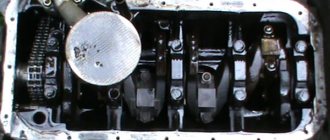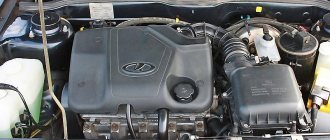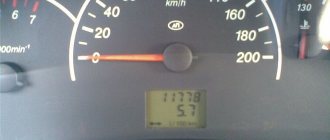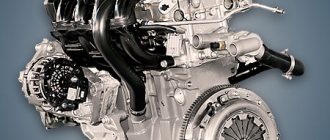Technical data VAZ 11183 1.6
- VAZ 11183 1.6 is a four-stroke gasoline engine, the four cylinders of which are arranged in one row.
- Power supply of the power unit, injection, distributed fuel injection.
- The cylinder block of the Lada Kalina internal combustion engine is made of especially durable cast iron. The gas distribution mechanism is single shaft, has 8 valves. The timing mechanism is driven by a toothed belt from the crankshaft pulley.
- The engine piston has a stroke less than the cylinder diameter of 75.6 mm and 82 mm, respectively. The compression ratio of the internal combustion engine is 9.6. The fuel used is AI 95. It is permissible to use AI 92, for which you need to change the ignition timing.
- Power VAZ 11183 1.6, at 5200 rpm min., 81 l., sec. Torque at 3000 rpm, min., 125 Nm.
- Environmental compliance standards: Euro 2, Euro 3.
Fuel consumption
Fuel consumption when driving around the city is 8.8 liters per 100 km, mileage. When driving on the highway 6.2 liters. Total consumption is 7.6 liters per 100 km, mileage.
Oil consumption
The permissible consumption of motor lubricant is 50 grams per 1 thousand km. Types of oil used: 5W40, 10W40, 5W30, 15W40. The volume of engine lubricant in the VAZ 11183 1.6 engine is 3.5 liters. When changing, fill in 3.2 liters. Manufacturers recommend changing the oil every 15 thousand km.
Resource
Engine operating life according to factory data is 150 thousand km. In reality, in the right hands, the VAZ 11183 1.6 can last up to 300,000 kilometers.
Technical characteristics and device
The VAZ 11183 engine began to be developed back in 1997, when the time came to move away from carburetor engines and fully launch all production lines of injection engines.
The first power units were installed on the VAZ 2109, but with the launch of such a famous sedan as the Lada Kalina, all models in this series received this engine.
Main technical characteristics of the Lada Kalina engine:
| Name | Characteristic |
| Brand | 11183 |
| Marking | 1.6 8V |
| Type | Injector |
| Fuel | Petrol |
| Valve mechanism | 8 valve |
| Number of cylinders | 4 |
| Fuel consumption | 9.6 liters |
| Piston diameter | 82 mm |
| Resource | 200 - 250 thousand km |
The 1118 engine is equipped with a liquid cooling system. In this case, the operating temperature of the engine ranges from 83 to 103 degrees Celsius. Four cylinders and eight valves allow optimal use of the resource capacity of the VAZ internal combustion engine.
Since the Lada Kalina engine was originally designed for installation on budget versions of VAZ cars, the maintenance cost was not expected to be high.
So, inexpensive semi-synthetic oils marked 5W-30, 5W-40, 10w-30 and 10W-40 are ideal for this power unit, which allows you to significantly save on maintenance. The receiver of motor 11183 was the engine that is installed on the Lada Granta - VAZ 21183.
With the rise in gasoline prices, many motorists began to install gas equipment on their cars. On the first models of the engine, after a short period of use, it became clear that the engine was not adapted for gas, as the piston group and valves quickly burned out. Therefore, in the future, the designers of the manufacturer took into account and corrected the defect.
General design features of internal combustion engines
The VAZ 11183 1.6 engine is a modified version of the already well-known carburetor power unit VAZ 21083. Most of the design elements are borrowed from this model. The cast iron cylinder block also has four in-line cylinders. But the aluminum cylinder head is adapted for distributed fuel injection. It has an overhead camshaft. The valves are driven by fists through pushers. Hydraulic compensators are not provided on this engine model. Because of this, periodic adjustment of the valves is required. Which you can do yourself by selecting the required number of steel washers.
The 11183 1.6 engine block is very similar to the VAZ 21083 power unit block. The only thing that has changed is the height of the cylinder block. As a result of these changes, the stroke of the piston group increased. It became 75.6 mm, instead of the previous 71 mm. Accordingly, engine capacity increased from 1.5 liters to 1.6 liters.
Design features of the VAZ 11183 timing belt
The camshaft of the gas distribution mechanism is driven from the crankshaft pulley using a toothed belt. Belt tension, unfortunately for drivers, is manual and brings a lot of trouble. Therefore, the belt often has to be tightened manually. A very important and pleasant point for owners of such an internal combustion engine is that when the timing belt breaks, the pistons do not meet the valves. This is possible thanks to the special design of the pistons, which has a recess in the upper part.
Modifications of the internal combustion engine VAZ 11183 1.6
This engine underwent a major modernization in 2011. On the new model, the receiver has been enlarged, and the throttle valve has received an electronic control system. The type of throttle control is called E-gas. The new engine acquired its own VAZ 11183-50 index, and its power increased to 82 hp. What is also important is that the VAZ 11183-50 began to comply with European compliance standards Euro 4.
It should be noted that in parallel with the VAZ 11183 engine, the VAZ 21114 engine was produced. By and large, this is the same engine. Most systems, components and mechanisms are identical.
However there are some differences:
- in the power system of the VAZ 21114 engine they used a completely different generator 5132.3771 for 90 Amp hours;
- a new fastening method was used to mount the generator;
- To drive the generator, a new belt with a thickness of 882 millimeters was used. The mechanism for tensioning the belt has also been changed.
All other components, systems and mechanisms of the engine are completely the same, despite the fact that the motors were produced in different production shops.
Weaknesses of the VAZ 11183 engine
The most frequently recurring weaknesses are the Generator. Suddenly, after purchasing a new car, you began to hear an incomprehensible hum under the hood? There may be many reasons, but cynical statistics will indicate to you that most likely you are faced with the destruction of the generator bearing. The engine design does not provide a mechanism for adjusting the tension of the generator belt, and the driver can check the tension only by turning the belt 90 degrees. This problem can be resolved. It is possible to install a modified mechanism for tensioning and adjusting the alternator belt, which is available for free sale in auto supply stores.
Throttle valve. During the modernizations, the designers were able to solve the problem of rapid contamination of the throttle on previous AvtoVAZ engines and install an electronic throttle valve drive, but it still happens that the operation of the unit on the Granta engine is disappointing due to floating idle speed and spontaneous engine stops. The recipe is still the same - flushing the throttle assembly with carburetor cleaning fluid.
Mass air flow sensor. If you notice a loss of power, an increase in fuel consumption and a check light on the dashboard. These reasons indicate the need to check the mass air flow sensor, for which you need to arm yourself with a multimeter and a 10mm wrench. The driver should find the yellow wire output in the sensor connector (it is closer to the windshield) and the green output (third from the left on the same side ). These sensor outputs are exactly what we need. In cars of different years in the electrical circuits, the colors of these wires may differ, but the locations of the terminals are the same. To monitor performance, the voltage is measured between the indicated terminals with the ground turned on and the motor not running. The size of the tester probes is capable of passing through the rubber seals of the connectors, along the specified wires, without disturbing their insulation. We turn on the mass, connect the multimeter and observe. The voltage on a working sensor will be 0.996…1.01 Volts. If the voltage is up to 1 V, everything is in order - we look further for reasons, but if it is higher - we simply replace it with a new one and rejoice at the improvement in the throttle response and efficiency of the internal combustion engine.
Ignition coils are not highly reliable. Malfunctions with them are determined by a lit check on the device, a sharp decrease in power and weak acceleration. Fans of electrical circuits can test the coil with a tester for the presence of interturn short circuits. The solution is still the same - a banal replacement of the part.
Cooling system thermostat. The bypass valve gets stuck in the cold and the engine does not warm up or takes a very long time to warm up. This is due to the low quality of manufacturing of domestic parts. In case of similar problems, I recommend that owners find a compatible analogue of higher quality.
Electronic control unit. It is located under the front panel and, as a result, is often filled with coolant, since the hoses and pipes of the engine cooling system are in close proximity. An option to get rid of problems in the future is to move it under the glove compartment.
Valve mechanism. The valves on this engine can simply burn out. It is not yet clear whether the reason lies in the quality of the factory adjustment of thermal clearances or whether the fuel coupled with overheating is to blame. But one way or another, the scanner detects error P0363 and the owner urgently needs to go to the service center. Otherwise, problems may begin with the connecting rod and piston group.
Connecting rod and piston group. Those who did not have time to avoid burning out valves or sinking compression and oil rings will encounter problems such as high oil consumption and black smoky exhaust in all modes of internal combustion engine operation. There is only one way out - qualified repairs with replacement of rings. The use of low-quality oil and a clogged oil filter can lead to scuffing on the piston body and to the same crankshaft problems mentioned earlier.
Starter. If you hear the sound of the starter working, but the engine refuses to start, do not rush to blame the battery. The issue may be loose starter mounts or damaged rotor gear teeth that mesh with the flywheel; the solenoid relay may also have burned out. If the teeth are broken off or heavily worn, we will hear a grinding noise when the starter operates; if the relay fails, there will only be the sound of an idling electric motor. It’s not that difficult to fix: tighten the fastenings, replace the gear, replace the relay.
Recommendations for servicing the Lada Kalina engine
The service life of any engine depends on proper maintenance from the very first days of operation; the VAZ 11183 1.6 engine is no exception to the rule.
The manufacturer recommends servicing this engine in the following order:
- During the first kilometers of driving, the entire car undergoes grinding in of parts, including the engine. The grinding-in period is called the running-in period. It lasts about 1.5 thousand kilometers. After it expires, you need to replace the engine lubricant and the oil filter element.
- The next stage of maintenance must be performed after a mileage of 10 thousand kilometers. The engine oil and oil filter must be replaced. Also, at this stage it is necessary to change the air filter, measure the compression in the cylinders and adjust the valves.
- After 20,000 kilometers, it is necessary to diagnose all mechanisms and systems of the internal combustion engine. Naturally, you need to change the engine oil, since it must be replaced every next 10,000 kilometers.
- After 30 thousand, you only need to change the engine lubricant and filter element
- After a mileage of 40 thousand km, many engine elements and parts must be replaced:
- replacing the air flow filter element;
- replacing the fuel filter element;
- replacing the timing belt and roller;
- replacing the alternator belt if necessary;
- replacing the pump at the slightest play in the fuel pump pulley;
- replacing the valve cover gasket;
- other parts requiring replacement;
- In addition to replacing parts, during this period of operation the valves should be adjusted and diagnostics of the internal combustion engine systems should be carried out.
Subsequent maintenance must be carried out in accordance with points 2 and 5. The exception is motor oil and filter. They need to be replaced every 10 thousand kilometers.
Oil change video
Repair (cost, warranty)
Repair in the simplest situation will start at 15 thousand rubles, depending on the region and the qualifications of the technician. The saddest thing is that these situations also arise at short mileage, about 15,000 km. But in this case, you can still contact your official dealer for warranty. This type of work is guaranteed.
Since when the timing belt breaks, the valves also break on 16 valves, a heated discussion has developed on our website about which engine is better: 8 or 16 valves.
How to check the condition of the timing belt?
To visually check the timing belt, you must remove the timing cover. This is not difficult to do; with 8 valves there is a lot of space under the hood. Remove the cover and begin a visual inspection of the belt. It should be like new, without cracks or rips, without dirt or deposits, and dry.
If the condition of the belt causes concern, then it must be replaced, for more details, see the article: replacing the timing belt on an 8-valve Granta.
Possible malfunctions of VAZ 11183 1.6
The VAZ 11183 engine is an improved version of the VAZ 21083. Most of the possible malfunctions for these engines are similar:
Flow sensor
For cars, a number of VAZ models, including Lada Kalina and Lada Granta, stopping the engine while driving is popular. Experienced drivers know that the culprit of the breakdown is the sensor responsible for mass fuel consumption. When replacing this sensor, the engine will start without problems.
Oil leaking
A popular problem is engine lubricant leaks. Oil can leak through the valve cover gasket, gaskets and seals. Sometimes a leak can be so critical that complex repairs cannot be avoided. Critical failures include oil leakage through the crankshaft seals.
Overheat
Overheating of the VAZ 11183 power unit occurs due to the thermostat. Unfortunately, the quality of domestic spare parts leaves much to be desired. A newly installed thermostat may not work. The motor may overheat, or on the contrary, it may not heat up.
Engine knock
Knocks in the power unit are a real problem for many VAZ cars. It is necessary to take into account the fact that the engine knocks when cold. If the engine has already warmed up and the valve clearances have been adjusted, the problem may be more serious. To determine the problem, you will need to diagnose the internal combustion engine.
ECU
The control electronics on the VAZ 11183 1.6 engine is one of the sore spots. Most drivers have encountered its replacement. There may be several reasons for this. For example: increased fuel consumption, the engine cannot develop full power, idle speed failure.
Engine tripping
If the engine starts to stall, you need to check the spark plugs. If the spark plugs are OK, then the ignition coil has failed. Very rarely a valve can burn out.
The revolutions are floating
If the engine speed fluctuates, then with a high probability it can be said that a dirty throttle valve is to blame. Often the cause may be a failed electronic sensor.
Crankshaft bearings
If, when accelerating, you can hear the sound of metal in the engine, then there is a high probability that the crankshaft liners are rattling. Further operation of the vehicle is not advisable until the problem is resolved. Otherwise, scuffs may form on the crankshaft journals.
As can be seen from everything described above, the VAZ 11183 power unit has many weak points and possible malfunctions. However, given the simplicity of the engine design, drivers fix most internal combustion engine problems themselves. Here, it must be said that spare parts for the VAZ 11183 are low in cost. Thanks to these circumstances, many domestic drivers fell in love with this engine. They consider it a reliable, easily repaired power unit.
Engine 21116 (87 hp) - the valves bend!
21116 engine bends valve
This engine is installed on the Lada Granta in the “Norma” configuration. And it also bends the valves, unfortunately.
Main article: Engine 21116: reviews, service life before major overhaul - a detailed review of the engine from Grantovodov!
Engine 21116 (87 hp) is one of the most common in Lada Granta cars.
In order to increase power, AvtoVAZ designers had to install a lightweight piston group in the 114 engine. This has led to the fact that the space for the recesses in the pistons is now completely absent, which means that the piston will 100% bend. Since the piston has become thinner, with a high degree of probability the piston, after “meeting the valves,” will also become unusable and fall apart.
The only difference between 21116 and 11186 is that the first is installed with an imported connecting rod and piston group, and the second with a domestic one.











